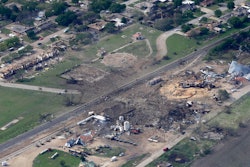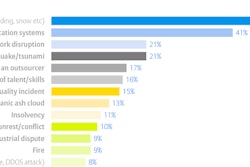Takeaways
- Develop contingency plans that look at a wide variety of potential disruption scenarios
- Look deep into your supply chain to understand vulnerabilities several tiers deep into your supply chain
- Start thinking about the unthinkable – before it happens
It's said that the only things we can be sure of are death and taxes. But there is a third: uncertainty.
Whether natural disasters like the earthquake and tsunami that ravaged Japan, or the political upheaval that has the Middle East in turmoil, we just don't know what's going to happen or when, but somehow we have to plan for it. After all, those events affect the entire supply chain from raw product to delivery.
"One thing that weighs heavily on the supply chain is uncertainty," says Paul Martyn, vice president of BravoSolution in Chicago. "Look at the Middle East and the supply of oil. There's a lot of concern over the volatility in the oil markets. There was a 20 percent price rise in a short time."
Unfortunately, planning for uncertainty is easier said than done. In fact, it's not done enough, says Jeff Karrenbauer, president of INSIGHT, Inc. in Manassas, Va.
"Firms have a tendency to put off contingency planning until the next crisis hits," he says. "Well, guess what? They need wait no longer. The future is now. The typical reaction of management is to ask the staff to prepare some spreadsheets and perhaps monitor some KPIs (key performance indicators) in a business intelligence (BI) system. Wrong on both counts. There is not a spreadsheet in existence that can handle the complex interrelationships inherent in global supply chains, and BI systems are chock full of simplistic ratios and performance ranges that are useless when it comes to professional contingency planning. Serious prescriptive analytics are worlds removed from descriptive tools."
But, does anyone plan? "Some do, most don't," says Johan Selle, director of the business resiliency practice for iJet, a provider of enterprise risk management technology and integrated crisis response services based in Annapolis, Md. "Cisco, for example, has some really robust procedures. They very swiftly made the right decisions. Procter & Gamble, when they shut down in Egypt, were ready to move elsewhere. Sometimes a company needs to put a plan in place on risk assessment. Not everybody had plans for Egypt, but they had done it for earthquakes and other natural disasters. This is just one more piece they need to consider."
Middle East Muddle
Oil seemingly was the first concern of most people when the Egyptian uprising began. Bahrain and Libya followed suit. Thoughts immediately turned to the Suez Canal.
According to a report from Drewry Supply Chain Advisors, European container imports from Asia are particularly reliant on the Suez Canal, with as many as 14.2 million teu (twenty-foot equivalent units, a 20-foot-long intermodal container) being carried through the Suez.
What would happen if the passage through the Suez was cut off?
"That's even more nuanced than the press covered," says Gene Tanski, CEO of Demand Foresight, the provider of demand forecasting software headquartered in Golden, Colo. "It doesn't preclude availability. They could go around Africa. It would be a six- or seven-day trip. They'd take a one-time hit and it would have driven up the shipping rate. If they'd gone around Africa, the trip would be riskier and prices would have gone up."
The Suez Canal remains open, but, says iJet's Selle, there's a definite ripple effect.
"One of the things I saw in Egypt was the interconnectivity of things," he says. "For example, they instituted curfews. Fair enough. But people weren't getting to the worksite as early as they normally do. Instead of 7 a.m., it's 8 or 9. And to be off the streets by a 3 p.m. curfew, they have to leave work at 2. The curfew threw a curveball.
"Now," he adds, "they're looking at closures. Again, it's the ripple effect. Gas stations close down. Workers can't get to the refinery or distribution center. Now the distribution is affected. Trucks can't run because they didn't get gas."
Still, the ripple moves on, directly affecting the financial engine of the supply chain. "Letters of credit play a big role," Selle says. "If the banks are closed, you can't make payments and business stops. There are communication disruptions. I haven't used a fax machine in 10 or 15 years. If the Internet is down, how do you get critical documents out? In the case of telephone communications, the government had time to shut down the local phone network. If they shut that down, your driver is sitting with a cell phone on his lap. How can he communicate with you?"
Fuel is always a problem, says Bob Rich, CEO of Buffalo, N.Y.-based ROAR Logistics. "In Libya, prices are going through the roof. There' no crystal ball. They hold the keys in terms of what's going on in the refineries. Libya is the largest producer of light sweet crude. It's most in demand for refining diesel, and that will be an issue."
Every product that goes to market is touched by a mode of transportation. Fuel, as noted, is a problem, but with the political unrest going on, there's more.
"If you're moving goods and you get to the airport or seaport and see tanks there, what happens?" asks Selle. "Your goods that normally take 30 minutes to load now take an hour-and-a-half. The longer that truck sits there full, the more money it costs. You read about thousands of people at the airport. If that's congested with passengers, moving cargo will be difficult also. We had aircraft on the ground, loaded. Hours on the ground is money in the supply chain business."
And the roads that lead from plant to dock or airport won't be smooth going, either, he adds. "Your drivers know when the main routes are shut down, but they know the back roads. In Cairo, especially, people were concerned so they put up roadblocks on the back roads. The drivers can't go that way, now. So many things are at play throughout the supply chain."
Ripples from Japan
The Japanese crisis is worsening and sending ripples of its own around the world. Factories, ports, roads, railways and airports have been shut down or damaged by the earthquake and tsunami. That means automotive and technology companies have no way of receiving goods from suppliers in the area.
At the time of this writing, Subaru had suspended overtime at its only North American plan in Lafayette, Ind., and Toyota had canceled overtime and Saturday production at its 13 North American plants, primarily to conserve inventory, according to the Associated Press.
A sufficient supply of Japanese-made chips for consumer electronics also is at risk. Toshiba and Renesas Electronics Corp. have temporarily closed facilities because of the quake, says the AP.
The economic impact is enormous. Analysts at IHS iSuppli estimate that Japan accounted for 13.9 percent of all global electronic equipment factory revenue in 2010, producing $216.6 billion worth of electronic equipment. Japanese suppliers accounted for more than 20 percent of global semiconductor production last year, generating $63.3 billion in microchip revenue.
The report adds that a major impact may be on Japan's production of components for LCD panels, including glass, color filters, polarizers, cold cathode fluorescent lamps and light-emitting diodes (LEDs).
Dale Ford, senior vice president at IHS iSuppli, which focuses on research regarding the electronics industry, said on an IHS Webcast on March 24, said that the interruptions to electric power related to damage to power plants in the quake-affected area, and subsequent rolling blackouts that have impacted the entire country, have had a sharply negative effect "that is broad and deep" to every stage of the electronics supply chain.
Ford suggested that it will take many manufacturers four to six months to get back to full capacity, depending on the distance of their plants from the quake's epicenter and the speed with which Japan is able to get the electric power grid back on line. The disruption, in the meantime, will be particularly acute in the electronics and automotive industries.
None of this even considers the psychological impact of radiation as Japan struggles with its severely damaged nuclear plants, says ROAR's Rich. "What will be the impact of this on Japan as an export nation? If they get a meltdown, panic will have global impact. Nuclear radiation is a psychological aspect as well as a trade impact."
Rich continues: "When they export for the next six months to a year, will people be afraid of nuclear contamination of the containers and products? People may look to alternative sources because of their fear of radioactivity. People may not view Japan as a safe trading network. You can't control fear. There could be major shifts in the supply chain."
What to Do
"The government changed in Tunisia and Egypt," Selle says. He points out that companies typically move into a market with the thought of setting up an infrastructure with good contacts within the government. Suddenly those contact may not be available anymore. Your support network can change.
"What we try to do," Selle continues, "is work with our clients, get relevant information like port closures, protests, upheaval, airport closings. We analyze the situation for our clients and get them information so they can make well-informed risk decisions."
Demand Foresight's Tanski says companies must have a "what if" strategy. "Client supply chains are global," he says. "If price increases, that's a 'what if.' What if you don't have enough product? Do you default to the highest-volume customers? What do we do?"
BravoSolution's Martyn advises a strategic approach. "From a purchasing and procurement view, you want to investigate even your suppliers' suppliers. You have to understand multiple levels of your supply chain."
A final warning comes from Insight's Karrenbauer, who cites a study from analyst firm Aberdeen Group that reported only 13 percent of the companies they surveyed had formally addressed supply chain vulnerabilities.
"This is simply irresponsible management, a failure of fiduciary responsibility to the shareholders, because it can place the enterprise itself at risk," Karrenbauer warns.
Instead, he advises, companies must conduct various scenarios and develop contingency plans for each one, creating a strategic supply chain that serves as a cornerstone for a comprehensive business continuity plan.
Links
BravoSolution www.bravosolution.com
Demand Foresight www.demandforesight.com
Drewry Supply Chain Advisors www.drewrysupplychains.com
IHS www.ihs.com
iJet www.ijet.com
INSIGHT, Inc. www.insight-mss.com
ROAR Logistics www.roarlogistics.com














